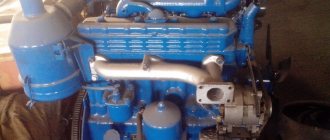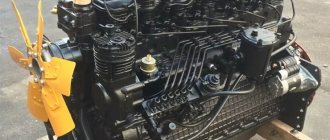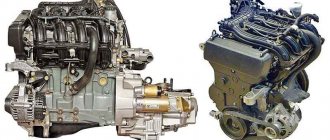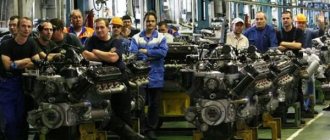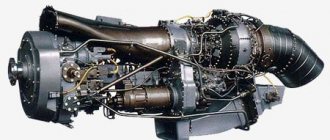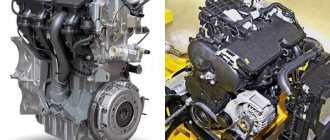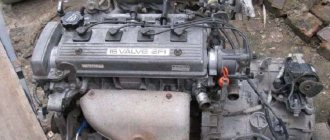The MTZ-80, MTZ-82 and MTZ-80L, MTZ-82L tractors are equipped with a four-cylinder, four-stroke diesel engine with a nominal power of 80 hp. pp.: respectively D-240 (with electric starter) and D-240L (with starting engine). The D-240 engine has a torque of 28 kgf*m, which is enough to complete most of the tasks. The design solution was to use a non-separated type working chamber on the power unit. In addition, there is double fuel injection, with the formation of working fluid vapors by volume and distribution of the fuel in the form of a film over the cylinder and piston. Thanks to the solution, it is possible to obtain an effect using the engine resource and realize the potential. Thus, the dynamic characteristics of the unit are higher, which makes it possible for the motor to cope with a large number of assigned goals. In order to improve mixture formation, the designers made the working chamber in the form of a ball; this creates vortex flows inside the chamber and uses the generated heat effectively. The power plant produces 80 horsepower at 2200 min-1 crankshaft revolutions. Such indicators guarantee traction in the rev range. High-strength gray cast iron helps the cylinder block of the power unit avoid thermal deformation. The material made the motor heavy, the mass of the D-240 engine is 430 kg, this justified itself, since the motor does not have diseases inherent in similar mechanisms.
Technical characteristics of the MTZ-80 d-240 engine
• Engine model – D-240 Traction class – 1.4 t. • Power (Diesel) – 59 (80) kW/l. With. • Number of forward/reverse gears – 18/4 Tractor dimensions length/width/height – 3815/1970/2470 mm. • Front/rear wheel track – 1200–1800/1350–2100 mm. • Weight - 3160 kg. • Speed range – from 1.3 to 35 km/h. • Agrotechnical clearance – 470 mm. • Turning radius – 4.1 m.
Diesel D-240, four-stroke, four-cylinder, water-cooled engine, produced by the Minsk Tractor Plant. The working volume of the cylinders was 4.75 liters. At a nominal speed of 2200 rpm. min. this engine produces 80 hp. Semi-separate combustion chamber. The diesel engine weighs 430 kg. Some modifications include the installation of a pre-heater PZHB-200B. There are two options for starting the engine: electric starter, or using a starting carburetor engine. There is a start lock in case the tractor is stopped at speed.
To ensure that this reliable engine does not let you down and works like a clock, it is necessary to carry out technical inspection and maintenance every: 60, 240 and 960 engine hours. A complete list of work for each maintenance is described in the operating instructions.
The engine uses an undivided combustion chamber with volume-film mixture formation. Part of the injected fuel is sawn into the volume of the combustion chamber, and the other spreads over its surface, forming a thin film. The first part of the fuel is intensively mixed with the flow of compressed heated air, actively evaporates and burns: the process of so-called preliminary ignition of the fuel occurs. The combustion chamber is given a tent shape, which helps create turbulence in the air flow and better mixing of fuel and air. The second part of the fuel (in the form of a film) evaporates from the inside, being heated from the wall of the combustion chamber, and from the outside, in contact with the flow of compressed heated air (subsequent ignition of the fuel). The gradually developing process of fuel combustion creates conditions for economical and, as they say, soft operation of the engine, which is characterized by gradually increasing loads on the crank mechanism.
Design of the Belarus MTZ-82 tractor
Nissan X-Trail technical specifications, configurations, reviews
The dimensions of the MTZ 82 tractor are as follows:
- Height 2800mm;
- Width 1970mm;
- Length 3930mm;
The engine is four-stroke four-cylinder diesel, brand D-243 or D-240. It has a semi-separated combustion chamber, and some models are equipped with a PZHB-200B pre-heater.
Photo of the MTZ 82 tractor
The clutch is permanently closed, single-disc, dry. The transmission is dual-range, nine-speed with a reduction gearbox.
The tractor's hydraulic system is separate and includes a hydraulic drive, a pump (NSh-32), a power cylinder, a hydraulic accumulator, a hydraulic accumulator, a position regulator distributor and a rear linkage system.
The cabin is sealed, all-metal, with a rigid frame. It is equipped with: a single torsion bar seat, a heating and cooling unit, instrumentation, controls, a first aid kit, and a thermos.
The pneumatic system - distributor valve and compressor - provides control and control over trailer brakes in single-drive mode.
Gearbox and transmission MTZ-82
The gearbox of the MTZ 82 tractor provides the ability to select 1 of 9 speeds for moving forward, and 1 of 2 for moving backward. The inclusion of 1st, 3rd, 4th, 5th, 9th gears for forward movement and 1st reverse speed is carried out when the 1st stage of the gearbox is operating. Stage II allows you to engage 2, 6, 7, 8, 9 forward speeds and 2 reverse. To turn on the required speed, you must first connect the required gear stage (the correspondence diagram between gear stages and speeds is located in the tractor cabin). After the desired stage is engaged, the gearshift lever will be in the neutral position. From it the required gear is switched on.
Maintenance of the MTZ 82 tractor
In order to ensure uninterrupted and trouble-free operation, as well as to increase service life and efficiency, the tractor must undergo planned and regular maintenance. For these purposes, a 3-stage maintenance is provided.
- After 60 working hours
- After 240 working hours
- After 960 working hours
In addition, seasonal maintenance and special service are provided for machines operating in difficult climatic zones or special conditions (desert, mountainous areas, etc.). As a rule, when all necessary service activities are performed, tractor repairs come down to rare replacement of parts or components, flushing the cooling system, adjusting systems, updating lubricants and oils. The T-25 tractor is much more convenient.
Modifications of MTZ 82
Almost 40 years have passed since the first MTZ-82 was manufactured, during which time many new machines were created on its basis: MTZ-82.1, T-70V/S, MTZ-82R, MTZ-82N, T-80L, MTZ -82K, etc. To increase their functionality and give new capabilities, the drives, overall dimensions, transmission, ground clearance, hydraulic system were changed, and parts and more powerful engines were added. But even in this form, it can be used with more powerful equipment such as the Vector 410 combine.
Device D-240
1 - nozzle; 2 — block head; 3 - sleeve; 4 - piston; 5 - combustion chamber.
Engine D-240: a - right view;
b - left view : 1 - oil pan; 2 — back sheet; 3 — flywheel crown; 4 - oil filler neck; 5 — fuel coarse filter; 6 — air cleaner; 7 — exhaust manifold; 8 — cylinder head; 9 — electric torch heater; 10 - generator; 11 — thermostat housing; 12 - fan; 13 - water pump; 14 — fan belt; 15 — front support; 16 — crankcase; 17 — centrifugal oil filter: 18 — breather; 19 — oil gauge; 20 - fuel pump; 21 - nozzle; 22 — emergency stop mechanism; 23 — intake manifold; 24 — fine fuel filter; 25 - starter.
Engine D-240L (left view)
: 1 - starting engine air cleaner;
2 - starting motor; 3 - starting motor starter; 4 - starting motor gearbox (other parts are the same as those of the D-240 engine in the figure above). Figures a and b show a general view of the D-240 engine, and the bottom figure shows a general view of the D-240L engine. These drawings not only give an idea of the appearance of the engine, but also allow you to familiarize yourself with the relative location of its main and auxiliary components, mechanisms and devices. Like any diesel engine, the D-240 (D-240L) engine consists of a number of mechanisms and systems. The main ones are crank and gas distribution mechanisms and lubrication, cooling, power and starting systems. The crank mechanism
serves to convert the rectilinear reciprocating motion of the piston into the rotational motion of the crankshaft.
The gas distribution mechanism
is designed to admit portions of air into the cylinder and exhaust exhaust gases from it at strictly defined moments and periods of time.
The lubrication system
serves to supply lubricants to rubbing parts in order to reduce friction between them, as well as partially remove heat.
The cooling system
is necessary to maintain normal engine thermal conditions.
Diesel engines use a liquid (usually water) cooling system. The power supply system
is designed for accurately dosed and timely supply of fuel to the engine cylinders.
The starting system
is used to start the engine.
High pressure fuel pump
. If the diesel engine does not start or does not develop the required power, then the cause is a malfunction of the fuel system. Associated factors in this case are the presence of air plugs in fuel lines and filters, wear of pump elements and injectors, and incorrect installation of the fuel injection pump. The exact identification of a faulty part is the color of the smoke from the exhaust pipe. If the smoke is white, then the reason is definitely not in the fuel pump, but in the operation of the cooling system. If the smoke is gray or black, then this indicates oil getting into the combustion chamber, misfiring in the cylinders, or sticking of the needle in the nozzle body. To replace pump parts, it is partially disassembled. The nozzle must be replaced if there are cracks or kinks on it. The figure below (a and b) shows sections of the D-240 (D-240L) engine, which allow you to familiarize yourself with its general structure and examine its main mechanisms, components and systems.
Engine D-240 (D-240L): a - longitudinal section;
b - cross section: 1 - crankshaft; 2 - oil sump; 3 — oil pump receiver; 4 - oil pump; 5 — shock absorber; 6 - fan; 7 - water pump; 8 — piston pin; 9 - piston; 10 - valve; 11 — rocker shaft; 12 — air cleaner; 13 — rod; 14 - flywheel; 15 - camshaft; 16 — connecting rod; 17 — sleeve; 18 — oil filter; 19 — fuel coarse filter; 20 — exhaust manifold; 21 - head; 22 — head cover; 23 — cover cap; 24 — electric torch heater; 25 — intake manifold; 26 — nozzle; 27 — fine fuel filter; 28 - fuel pump.
Modifications
During the entire production period of the MTZ-80 tractor model, various versions were produced, equipped with mounted or trailed equipment for use in various fields. So, it is used by farmers, builders, and also in public utilities. The most common modifications:
- MTZ-80 is the original version.
- MTZ-80.1 – has an increased cabin size and rear-wheel drive (in the basic version it is front-wheel drive).
- MTZ-82 is an all-wheel drive version of the tractor.
- MTZ-80Х/80ХМ - is a three-wheeled version used for cotton cultivation. Has a ground clearance of 65 cm.
- MTZ-80L - designed for forestry activities, has a 60 hp engine. With.
- MTZ-82K is an all-wheel drive version of the tractor with an additional leveling and stabilization system. Designed for use on slopes.
Be sure to read: Tractor t 40 am
The MTZ 80 tractor, produced since the times of the USSR, was a popular vehicle of its time. Used for various business activities. This is due to its characteristics, the power plant used, as well as the presence of a large number of modifications.
Engine D-245
Diesel D245 is a 4-stroke piston four-cylinder internal combustion engine with an in-line vertical cylinder arrangement, direct injection of diesel fuel and compression ignition. Turbocharging is used. The positive qualities of diesel engines in general are, without a doubt, known to all motorists. The main factor is, of course, the high efficiency of diesel compared to its gasoline counterpart. Reduced fuel consumption and its lower cost make cars equipped with MMZ D-245 engines a lifesaver not only for small and medium-sized businesses, but also for large construction and agricultural companies. After all, the greater the capacity of the equipment in use, the higher the final savings. In addition, no one can dispute another positive quality of diesel fuel - its ability to act as a natural engine lubricant.
Technical characteristics of the D-245 engine
| Parameter name | D-245: in-line 4-cylinder diesel engine with direct fuel injection, meeting Euro 2 environmental standards |
| Cylinder diameter, mm | 110 |
| Piston stroke, mm | 125 |
| Cylinder displacement, l | 4,75 |
| Number and arrangement of cylinders | 4L |
| Type of gas exchange system | TW |
| Rated power, kW (hp) | 90 (122.4) - from 116 hp. up to 136 hp. |
| Rated rotation speed, rpm | 2400 |
| Maximum torque, N m (kgf m) | 422 (43.1) |
| Rotation speed at maximum torque, rpm | 1500 |
| Specific fuel consumption, g/kW h (g/l.h.h) | 210 (154) |
| Weight, kg | 600-640 |
Factory configuration of the D-245 engine
| Parameter name | D-245 |
| Starter: | 74.3708 (12 V) |
| Generator: | G9645.3701-01 (14 V) |
| Turbocharger: | TKR 6-00.02 (BZA Borisov) |
| Pneumatic compressor: | A29.05.000-A-06-BZA |
| Gear pump: | NSh 10Zh-3-04l |
| Fuel pump: | PP4V101f-3486 Moterpal (RAAZ Yaroslavl) |
| Water pump: | 240-1307010-A1 |
| Oil pump: | 245-1403010 |
| Clutch: | there is 1 disk |
| Clutch housing: | There is |
Have you decided to buy an MTZ engine?
Use our tips! The first thing you should pay attention to is the price of the engine. The fact is that it is possible to buy a good quality MTZ engine only at an adequate price. The problem of quality/price ratio is especially acute with used mechanisms. Therefore, we recommend buying a new MTZ engine. This way you will protect yourself from all kinds of breakdowns and malfunctions. Buying an MTZ engine with a guarantee is very simple - just find a suitable model in our catalog and fill out an application. When purchasing an MTZ engine, check the availability of all components. We do not recommend purchasing an MTZ engine without first inspecting all systems. After delivery of the unit, carefully check the condition of the tractor unit. This is the only way you can buy a high quality MTZ engine.
Design and operating features
The tractor is based on a semi-frame design with a front-mounted engine and large rear wheels.
Most modifications of the Belarus 82 have a 2 by 2 wheel arrangement, which provides high cross-country ability. The front and rear suspensions of the vehicles are different: a semi-rigid balancer suspension is installed at the front, and a rigid one at the rear. This decision is due to the functions of the front wheels, which simultaneously control the turn and act as the driving force. During transport operations, the operator can disengage the front drive axle to reduce tire wear and fuel consumption.
The tractor engine is connected to the transmission via a single-disc dry clutch with a mechanical drive. The transmission is divided into 3 parts: front axle, rear axle and gearbox. Until 1985, Belarus 82 was equipped exclusively with a manual transmission with 22 speeds (18 forward, 4 reverse gears). A large number of speeds was due to the presence of a reduction gearbox. Subsequently, transmissions appeared with the function of locking the rear axle using hydraulics.
The rear axle consists of a bevel final drive and 2 final drives with spur gears. Its design also includes a bevel differential with the ability to lock (automatically or forcefully). The front axle is represented by a split sliding beam with the ability to adjust the track.
The presence of a power take-off shaft expands the range of additional equipment used with the model. Service brakes are dry disc brakes (installed on the rear wheels). Disc brakes are also used as parking brakes.
All-wheel drive expands the vehicle's capabilities, but requires additional effort when driving, even with the use of hydraulic booster. In this regard, the steering on older versions of the Belarus 82 was often redesigned by adding a special dispenser with a pump. Due to this, car maintenance was simplified, and the required steering effort was reduced. In the standard version, the equipment is equipped with a “worm-helical rack” steering mechanism located in the engine compartment in front of the engine.
The tractor is equipped with a separate-unit hydraulic system of several types with the following main mechanisms:
- distributor;
- hydraulic pump;
- hydraulic accumulator;
- fittings, filters and pipelines;
- hydraulic cylinders;
- hydraulic tank;
- power regulator;
- hydraulic booster.
The main element of the system is the NSh-32 pump with a flow rate of 45 l/min.
Belarus 82 has a 12-volt electrical system with batteries located in a special niche at the rear of the cabin. Batteries have different capacities. The network voltage after start-up is maintained by the generator.
The tractor is equipped with 2 types of cabins. Initially, the equipment was equipped with a small cabin, which made it possible to master the production of the new model in a short time. Among its advantages were low weight, compactness and simplicity of design. The cabin could be removed without any problems and repaired in rural workshops. It turned out to have no less disadvantages. I could only dream about the comfort of work. There was practically no lining of the cabin, so dust and noise insulation were at a low level. The basic version did not include a heating system. Due to the small size of the glass, the operator's visibility was limited. Another drawback was the poor quality of the instrument panel, the electrical circuit of which regularly malfunctioned. The operator had to install the heater, wipers and upholstery himself.
In the mid-1980s, modifications with a large cabin appeared, which increased work comfort. The temperature inside was maintained by a heater and ventilation. The sealed interior did not allow dust to penetrate inside. Another plus was the comfortable chair with adjustments for weight and height.
